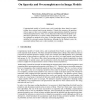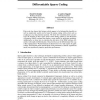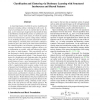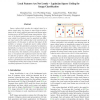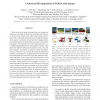ESANN
2006
14 years 8 months ago
2006
We investigate when sparse coding of sensory inputs can improve performance in a classification task. For this purpose, we use a standard data set, the MNIST database of handwritte...
NIPS
2007
14 years 8 months ago
2007
Computational models of visual cortex, and in particular those based on sparse coding, have enjoyed much recent attention. Despite this currency, the question of how sparse or how...
NIPS
2008
14 years 8 months ago
2008
Prior work has shown that features which appear to be biologically plausible as well as empirically useful can be found by sparse coding with a prior such as a laplacian (L1) that...
CVPR
2010
IEEE
14 years 10 months ago
2010
IEEE
A clustering framework within the sparse modeling and dictionary learning setting is introduced in this work. Instead of searching for the set of centroid that best fit the data, ...
CVPR
2010
IEEE
14 years 11 months ago
2010
IEEE
Sparse coding which encodes the original signal in a sparse signal space, has shown its state-of-the-art performance in the visual codebook generation and feature quantization pro...
ECCV
2010
Springer
14 years 11 months ago
2010
Springer
Recent research has shown the effectiveness of using sparse coding(Sc) to solve many computer vision problems. Motivated by the fact that kernel trick can capture the nonlinear sim...
ECCV
2010
Springer
14 years 11 months ago
2010
Springer
Sparse coding of sensory data has recently attracted notable attention in research of learning useful features from the unlabeled data. Empirical studies show that mapping the data...
ICPR
2010
IEEE
15 years 20 days ago
2010
IEEE
Given a sequence of observable features of a linear dynamical system (LDS), we propose the problem of finding a representation of the LDS which is sparse in terms of a given dict...
CVPR
2009
IEEE
15 years 1 months ago
2009
IEEE
Most research on image decomposition, e.g. image segmentation and image parsing, has predominantly focused on the low-level visual clues within single image and neglected the cont...
MIR
2010
ACM
15 years 1 months ago
2010
ACM
Sparse coding is a key principle that underlies wavelet representation of natural images. In this paper, we explain that the effort of seeking a common wavelet sparse coding of i...

